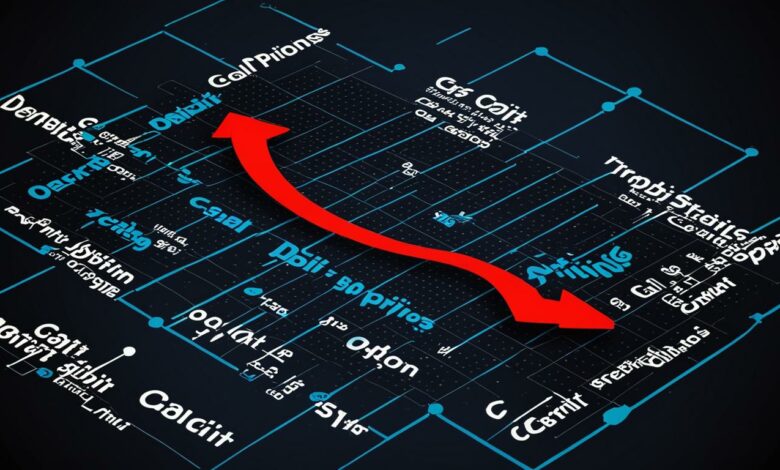Debit Spread Vs Credit Spread: Key Differences

In the world of options trading, credit spreads and debit spreads are two popular strategies that traders employ to capitalize on price movements. While both involve the simultaneous buying and selling of options, they differ in terms of the premiums paid/received and the trading environments in which they are most effective.
Key Takeaways:
- Credit spreads involve selling high-premium options and buying low-premium options, resulting in a net credit to the trader’s account.
- Debit spreads involve buying high-premium options and selling low-premium options, resulting in a net debit from the trader’s account.
- Credit spreads can be used in different trading environments and are particularly useful during periods of high implied volatility.
- Debit spreads are commonly used by beginners to offset the costs associated with owning long options positions.
- Credit spreads have potentially higher loss potential than initial premium collected, while losses in debit spreads are limited to the net premium paid.
Now, let’s take a closer look at credit spreads and debit spreads, exploring their characteristics, differences, and when it’s most appropriate to use each strategy in your options trading endeavors.
Credit Spreads
Credit spreads are a popular options trading strategy that involves selling a high-premium option and buying a low-premium option. By doing so, traders can generate a net credit to their account. These spreads can be used in various trading environments, making them flexible and adaptable to different market conditions.
Credit spreads are particularly useful during periods of high implied volatility. When market volatility is high, option premiums tend to be elevated, allowing traders to collect more premium when selling options. This can result in higher potential profits for credit spread traders.
Furthermore, credit spreads can be used to implement both bullish and bearish strategies, depending on the strike prices of the options involved. A bullish credit spread involves selling a higher strike call option and buying a lower strike call option, while a bearish credit spread involves selling a higher strike put option and buying a lower strike put option.
Here is an example of a bullish credit spread:
Strike Prices:
Option Strike Price Premium Sell XYZ Call $50 Buy XYZ Call $45
In this example, the trader sells the higher strike XYZ call option for a premium of $50 and buys the lower strike XYZ call option for a premium of $45. The net credit received by the trader is $5 ($50 – $45). If the price of the underlying asset remains below the higher strike price at expiration, the options will expire worthless, and the trader gets to keep the premium received.
Credit spreads offer defined risk and reward profiles, making them a popular choice among options traders. However, it’s important to note that losses in credit spreads can still occur if the underlying asset moves unfavorably beyond a certain threshold.
Now that we have explored credit spreads, let’s move on to examining debit spreads in the next section.
Debit Spreads
Debit spreads are a popular strategy used by options trading beginners to manage the costs associated with owning long options positions. This strategy involves buying a high-premium option and simultaneously selling a low-premium option, resulting in a net debit from the trader’s account.
Debit spreads can be utilized in both bullish and bearish market scenarios, depending on the strike prices of the options involved. In a bullish options spread, the trader aims to profit from an increase in the price of the underlying asset. On the other hand, in a bearish options spread, the trader expects the price of the underlying asset to decrease.
One of the key advantages of debit spreads is their limited risk. Unlike other options strategies, the maximum potential loss in a debit spread is capped at the net premium paid. This can provide a level of protection and certainty for traders, especially those who are new to options trading.
To further illustrate the concept of debit spreads, consider the following example:
Example:
Trader A is bullish on stock XYZ, which is currently valued at $50 per share. Trader A believes that the stock will rise to $60 within the next month. To capitalize on this bullish outlook while managing the risk, Trader A purchases a call option with a strike price of $55 for $3. Simultaneously, Trader A sells a call option with a strike price of $60 for $1. The net debit for this debit spread is $2 ($3 – $1).
Option Premium Strike Price Long Call $3 $55 Short Call $1 $60 If the price of stock XYZ reaches $60 or higher at expiration, Trader A’s debit spread will be profitable. The maximum potential profit for this trade is the difference between the strike prices ($60 – $55) minus the net debit ($2), which amounts to $3. This represents a 150% return on Trader A’s initial investment of $2.
On the other hand, if the price of stock XYZ remains below $55 at expiration, the debit spread will result in a loss. However, the maximum potential loss is limited to the net debit of $2.
In summary, debit spreads are a versatile strategy that can be used by options traders to manage costs and take advantage of bullish or bearish market conditions. By understanding the concepts and mechanics of debit spreads, traders can make informed decisions based on their market outlook and risk tolerance.

Debit Spread vs. Credit Spread – Identifying the Key Differences
Identifying the difference between debit spreads and credit spreads is crucial for options traders. While debit spreads involve a net cost, credit spreads result in a net credit. Moreover, credit spreads profit from time decay, whereas debit spreads profit from underlying asset price movements. Debit spreads have a higher maximum potential loss, while credit spreads offer a higher probability of profit. Understanding these differences is essential for traders to choose the most suitable strategy based on their market expectations and risk tolerance.
Scenario Analysis: Debit Spread vs. Credit Spread
When considering a scenario analysis of debit spread vs. credit spread, it’s important to note that in a debit spread, the underlying asset’s price must experience significant movement to yield a profit. On the other hand, credit spreads offer limited profit potential, making them a more conservative strategy. Additionally, credit spreads profit if the underlying asset’s price remains stable, while debit spreads generate profit from price movements. In terms of losses, debit spread losses are confined to the net premium, while credit spread losses can exceed the net credit.
Comparing Premiums
When considering call debit spread and credit spread strategies, it’s crucial to compare the premiums involved. The net premium for a call debit spread represents the maximum potential risk and cost of the strategy, while credit spreads involve a net credit, which is the maximum potential profit and the initial investment. Additionally, debit spreads have lower premium costs, resulting in a lower initial investment compared to credit spreads, making them an appealing option for traders. In contrast, credit spreads have a higher premium, offering a potential profit with a lower initial cost. This difference in premium structure significantly impacts the overall risk and profitability of each strategy.
Evaluating Cash Flow
When comparing debit spreads to credit spreads, it’s essential to evaluate the cash flow implications of each options strategy. Debit spreads necessitate an initial investment, resulting in a net debit, potentially leading to profits if the underlying stock price moves favorably. On the other hand, credit spreads generate a net credit, representing initial income, with potential losses if price movements are unfavorable. The differing cash flows significantly influence the trader’s investment strategy and market conditions, making it crucial to carefully assess the impact on cash flow.
Pros and Cons of Debit and Credit Spreads
Debit spreads offer potential profit and loss, while credit spreads provide limited maximum loss, making them a conservative strategy. Debit spreads suit traders anticipating price movements, whereas credit spreads benefit from stable prices. Credit spreads provide a net credit, impacting the trader’s goals. Debit spreads have lower initial investment, affecting cash flow, while credit spreads have higher initial cost, influencing market volatility. In essence, both options spreads have distinct advantages and drawbacks, catering to different trader preferences and market conditions.
Advantages and Disadvantages of Debit Spreads
Debit spreads enable traders to capitalize on underlying stock price movements, potentially yielding profits. The potential loss is limited to the net premium, reducing risk exposure. Moreover, the lower initial investment makes it a cost-effective strategy. However, compared to credit spreads, there is a higher potential loss, necessitating careful risk management. The initial cost influences investment strategy and market conditions, impacting spread choices. In bottom line, call debit spread’s advantages are balanced by potential disadvantages, requiring thoughtful consideration.
Pros and Cons of Credit Spreads
Credit spreads present a conservative options trading strategy with a higher likelihood of profit and a limited maximum loss, reducing the overall risk exposure. This limited risk, compared to debit spread strategies, offers a more secure approach. The net credit generated in credit spreads provides initial income but may lead to potential losses if the price movements are unfavorable. However, it’s important to consider that credit spreads also have limited profit potential, impacting options trading strategies and market volatility.
How Market Conditions Influence Choice of Spread?
In options trading, the choice between debit spreads and credit spreads is influenced by market conditions. In bullish markets, debit spreads are popular as they involve buying a lower-priced option. Conversely, in bearish markets, credit spreads are preferred as they involve selling a higher-priced option. Market volatility also plays a role, with credit spreads being riskier in highly volatile markets. Ultimately, individual trading strategies and risk tolerance determine the choice of spread.
How do Margin Requirements Impact the Choice of Spread?
Margin requirements play a crucial role in determining the choice of spread. Debit spreads require a lower initial investment, affecting account margin and risk exposure. On the other hand, credit spreads involve a higher initial investment, influencing account margin and potential profit/loss scenarios. Traders assess margin requirements alongside market conditions and asset price movements to make informed decisions.
When to Use Credit Spreads vs Debit Spreads
Traders often face the dilemma of choosing between credit spreads and debit spreads. The decision ultimately depends on the implied volatility percentile of the market. If the implied volatility percentile is above 50%, credit spreads become a favorable choice. On the other hand, if the implied volatility percentile falls below 50%, debit spreads are more suitable.
Credit spreads offer the advantage of being adaptable to various trading environments. They can be used in both bullish and bearish scenarios, taking advantage of price movements in either direction. Additionally, credit spreads thrive during periods of high implied volatility, providing traders with attractive premium opportunities.
Debit spreads, on the other hand, work well in low implied volatility environments. They are commonly used by options trading beginners to offset the costs associated with owning long positions. Debit spreads limit potential losses to the net premium paid, making them a more conservative approach compared to credit spreads. However, they should be used strategically based on the trader’s expectations for the underlying asset’s price movement.
When deciding between credit spreads and debit spreads, it’s crucial for traders to assess the current market conditions. By considering the implied volatility percentile and the expected direction of the underlying asset, traders can select the most suitable strategy. Remember, each strategy has its advantages and the choice should align with the trader’s risk tolerance and market expectations.
Conclusion
To summarize, both debit spreads and credit spreads are popular options trading strategies, but they have distinct differences. Debit spreads involve paying upfront for the trade, while credit spreads involve receiving a premium upfront. Debit spreads offer limited risk and unlimited profit potential, whereas credit spreads offer limited profit potential and limited risk. Market conditions and margin requirements play a significant role in determining which spread is more suitable for a given situation. It’s crucial to understand the pros and cons of each strategy before implementing them. Ultimately, choosing the right spread depends on your risk tolerance, market outlook, and trading objectives. Make informed decisions based on thorough analysis and consult with a professional if needed.







